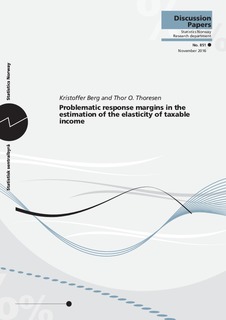| dc.contributor.author | Berg, Kristoffer | |
| dc.contributor.author | Thoresen, Thor Olav | |
| dc.date.accessioned | 2018-01-30T12:24:18Z | |
| dc.date.available | 2018-01-30T12:24:18Z | |
| dc.date.issued | 2016-11-23 | |
| dc.identifier.issn | 1892-753X | |
| dc.identifier.uri | http://hdl.handle.net/11250/2480658 | |
| dc.description.abstract | The elasticity of taxable income (ETI) is known to represent a summary measure of tax efficiency costs, which means that further information about the behavioral components of the ETI is not required for its use in tax policy design.
However, as there are response margins that may cause biases in the estimation of the elasticity, we advise against neglecting information about the composition of the behavior seized by the ETI. When using responses of the Norwegian self-employed to the tax reform of 2006 for illustration, we discuss how four different responses relate to the overall ETI, given characteristics of the reform. Effects on working hours, on tax evasion, and from shifts in organizational form and across tax bases are discussed in terms of to what extent they represent sources to estimation bias, or enter into the ETI in a decompositional way. We provide empirical illustrations of the effects of each of these margins. | nb_NO |
| dc.language.iso | eng | nb_NO |
| dc.publisher | Statistics Norway, Research department | nb_NO |
| dc.relation.ispartofseries | Discussion Papers;No. 851 | |
| dc.subject | Marginalskatt | nb_NO |
| dc.subject | Inntekter | nb_NO |
| dc.subject | Forbruk | nb_NO |
| dc.title | Problematic response margins in the estimation of the elasticity of taxable income | nb_NO |
| dc.type | Working paper | nb_NO |
| dc.subject.nsi | VDP::Samfunnsvitenskap: 200::Økonomi: 210 | nb_NO |
| dc.source.pagenumber | 40 s. | nb_NO |
